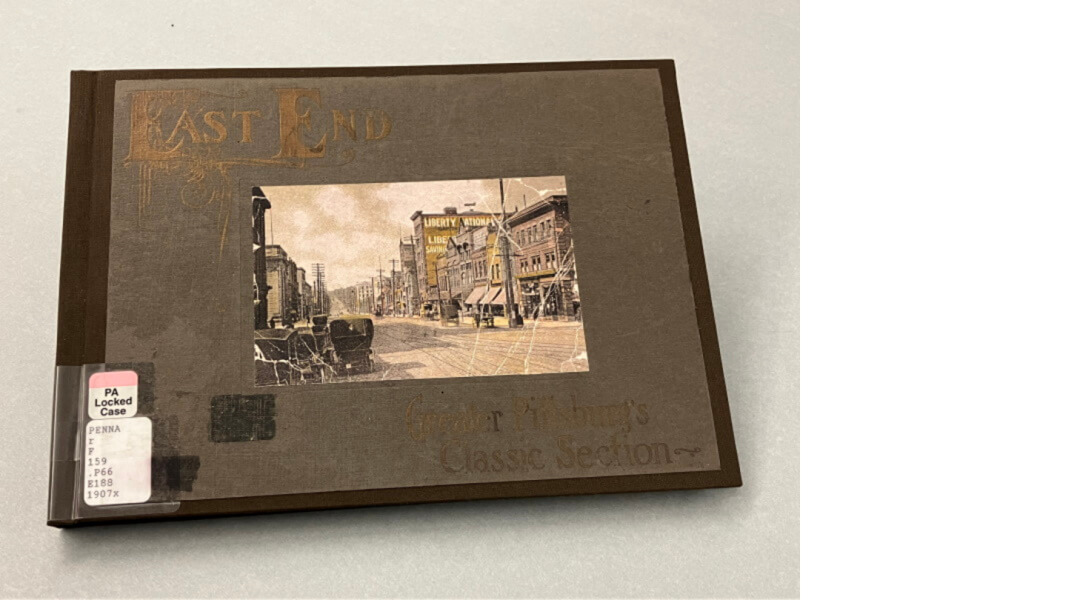In the Preservation Department at CLP, we see books that enter the lab in varying states of disrepair. While some of our preservation “patients” are simply in need of a little TLC, others require much more attention. “Up-Town, Greater Pittsburg’s classic section : East End, the world’s most beautiful suburb” was a book that needed more than a little TLC.
Before going on, let’s give our book the nickname of “East End” for the sake of brevity. “East End” was published in 1907. At 115 years old, the paper was likely made from wood pulp fibers. Over the years, the pages became acidic, breaking down the paper pages causing them to become brittle and weak and eventually breaking off at the hinge. This is likely due to the weakened state of the paper and also a result of over a century of use. And since this is a really cool book, it probably has been used quite a bit.
Here are some images of a book with the very same issue:
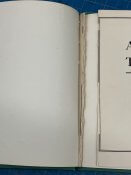
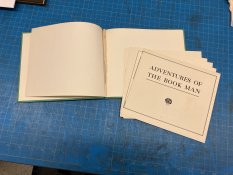
What happens next when a book is in this condition?
That’s where the Carnegie Library Preservation Department comes in and works its preservation magic. We want our patrons and fellow staff to have access to the materials in the collection.
So, how can we improve access to this item – that is currently, a pile of loose brittle pages?
Well, we can turn it back into a book!
This is something we can do. Preservation Department staff have gone to school specifically to learn how to repair and preserve fragile books. What we don’t do is restoration. That is a different process involving materials that are most likely not archival and the repairs are not reversible. Unlike the restoration process, preserving an item like a book is about providing access to it while using materials that are acid-free, neutral and reversible (archival). That way, if anyone comes along in the future and wants to undo the repairs, they can!
Now, let’s get back to what happened to “East End” once it started to get treated in our lab.
Here’s a breakdown:
Step one: First, the loose pages from the remains of the textblock are carefully separated.
Step two: A quick note about how the textblock of this book was put together. The individual pages were attached as signatures. A signature is a sheet of paper where multiple pages are printed on each side of the sheet. The sheet of printed pages is then folded down to become one of the multi-page sections of a bound book. Pretty cool, right?
For example, one signature has 4 pages on it…
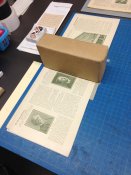
Then, in order to reconstruct the signatures of a book like “East End,” we need to mend the paper signatures back together. To do that, we use very thin paper tissue called long-fiber tissue or sometimes called Japanese tissue. We use wheat starch paste as the glue to adhere the tissue. The long-fiber tissue is then carefully torn into a strip, paste is applied to it, and it is laid down in the middle of the torn signature, adhered the two sides together into one whole piece. This technique is called “guarding.”

Step three: After all the signatures have been mended, they are attached back together into a textblock. There are two main methods to achieve this, by gluing it or by sewing it together. Since this book was originally sewn, we are going to sew it again. We will also sew fresh, new endpapers at the front and back of the book.
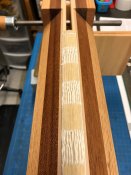
Step four: Now that we have a textblock again, we have to give it a hard, protective cover in order to protect the paper. This protective cover is called the “case”, which is commonly called the cover of a book. And attaching the textblock to the case is called “casing-in.” For this book, we constructed a fresh new case with brown bookcloth and acid free book board. The textblock gets a piece of mesh attached to it, called “crush” or “super.” It kind of looks like a little cape when attached to the spine of the textblock and it helps with attaching the textblock to the case of the book. Next, we adhere the case to the textblock and then place the book in the book press. The press is used to put weight on the book, so that the pages dry flat. This usually takes about 24 – 48 hours.
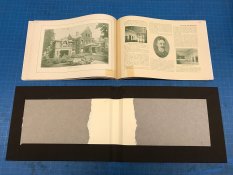
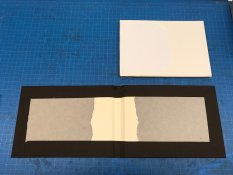
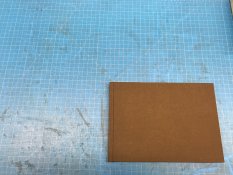
Step five: Remove the book from the press. And now that the text block is attached to the case, it’s time to adhere any original cover artwork back on the cover. In this particular instance, “East End’ originally had a decorative cover with gold lettering and a color image of East Liberty. The Carnegie Library’s image had been torn, creased and half of it was missing.
Luckily, we have a few wonderful collecting institutions in this region. So, we called up the Heinz History Center (HHC) to see if, perhaps, they had a copy of this book and if their image was in better shape than our image. And in fact, they did have a copy of “East End” with an intact image for us to use! We got a digital image of it and printed the image on archival paper and then adhered it to the front of the book. Lastly, labels with catalog information were added to the spine of the book so that we can keep track of where the item is and it is placed on the shelf.
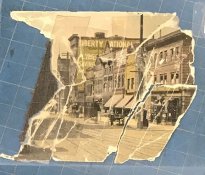
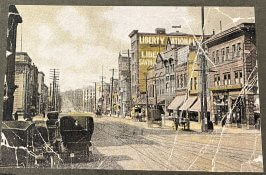
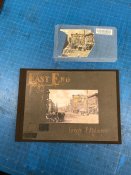
Today, anyone can access this book that documents local history about the East End of Pittsburgh around the turn of the 20th century. There is currently an eBook and reference copy available through our library’s catalog.
Happy reading!
References:
German Case (Bradel) Binding, by Peter D. Verheyen. Originally published 2002, re-written with new illustrations 2006. Published in Skin Deep, Volume 22 – Fall 2006.
Bookbinding and the Conservation of Books, A Dictionary of Descriptive Terminology:
Etherington & Roberts. Dictionary–Table of Contents

